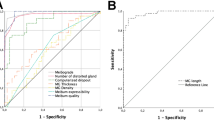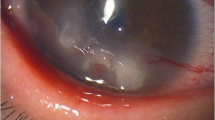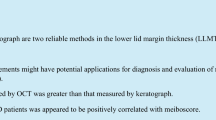Abstract
Purpose
To quantitatively evaluate the morphological parameters of meibomian glands (MGs) and lipid layer thickness (LLT) in patients with keratoconus (KC).
Methods
In this prospective, cross-sectional study, 164 eyes of 164 keratoconus patients and 64 eyes of 64 age-matched control subjects were included. An advanced automatic MG analyzer was used to quantitatively measure the morphological and functional parameters of MGs. Morphological and functional parameters of MGs, LLT, and other ocular surface parameters were compared between the control and KC groups.
Results
The mean meibomian gland diameter, length, square, and gland area ratio (GA) were all significantly decreased in the KC group (all P < 0.05), while no significant difference was observed in the gland tortuosity index (TI) and gland signal index (SI) between the KC and control groups (all P > 0.05). There was no significant difference in the number of total and incomplete blinking among patients with different stages of keratoconus (all P > 0.05). The gland diameter, square, and TI were all negatively associated with KC severity (all P < 0.05), while no significant difference was observed among all stages of KC in gland length, GA, and SI (all P > 0.05). Moreover, the LLTs were positively correlated with the gland diameter, square, GA, and TI and negatively correlated with anterior corneal curvature or KC severity (all P < 0.05).
Conclusions
Atrophic morphological changes in the meibomian glands were closely correlated with the severity of keratoconus. Gland diameter may be a sensitive functional morphology metric of meibomian glands in patients with keratoconus.



Similar content being viewed by others
References
Rabinowitz Y (1998) Keratoconus. Surv Ophthalmol 42:297–319. https://doi.org/10.1016/s0039-6257(97)00119-7
Dogru M, Karakaya H, Ozçetin H, Ertürk H, Yücel A, Ozmen A, Baykara M, Tsubota K (2003) Tear function and ocular surface changes in keratoconus. Ophthalmology 110:1110–1118. https://doi.org/10.1016/s0161-6420(03)00261-6
Kymes S, Walline J, Zadnik K, Sterling J, Gordon M (2008) Changes in the quality-of-life of people with keratoconus. Am J Ophthalmol 145:611–617. https://doi.org/10.1016/j.ajo.2007.11.017
Dienes L, Kiss H, Perényi K, Nagy Z, Acosta M, Gallar J, Kovács I (2015) Corneal sensitivity and dry eye symptoms in patients with keratoconus. PLoS ONE 10:e0141621. https://doi.org/10.1371/journal.pone.0141621
Nelson J, Shimazaki J, Benitez-del-Castillo J, Craig J, McCulley J, Den S, Foulks G (2011) The international workshop on meibomian gland dysfunction: report of the definition and classification subcommittee. Invest Ophthalmol Vis Sci 52:1930–1937. https://doi.org/10.1167/iovs.10-6997b
Mohamed Mostafa E, Abdellah M, Elhawary A, Mounir A (2019) Noncontact meibography in patients with keratoconus. J Ophthalmol 2019:2965872. https://doi.org/10.1155/2019/2965872
Martínez-Pérez L, Viso E, Touriño R, Gude F, Rodríguez-Ares M (2022) Clinical evaluation of meibomian gland dysfunction in patients with keratoconus. Contact Lens Anterior Eye : J Br Contact Lens Assoc 45:101495. https://doi.org/10.1016/j.clae.2021.101495
Uçakhan Ö, Özcan G (2023) Morphological and functional assessment of the tear film and meibomian glands in keratoconus. Eur J Ophthalmol 11206721231173167. https://doi.org/10.1177/11206721231173167
Deng Y, Wang Q, Luo Z, Li S, Wang B, Zhong J, Peng L, Xiao P, Yuan J (2021) Quantitative analysis of morphological and functional features in meibography for meibomian gland dysfunction: diagnosis and grading. EClinicalMedicine 40:101132. https://doi.org/10.1016/j.eclinm.2021.101132
Xiao P, Luo Z, Deng Y, Wang G, Yuan J (2021) An automated and multiparametric algorithm for objective analysis of meibography images. Quant Imaging Med Surg 11:1586–1599. https://doi.org/10.21037/qims-20-611
Wu Y, Jiang H, Zhou X, Zhai Z, Yang P, Zhou S, Gu H, Xu J, Hong J (2022) Morphological and functional changes of meibomian glands in pediatric and adult patients with allergic conjunctivitis. J Clin Med 11. https://doi.org/10.3390/jcm11051427
Rabinowitz Y, Rasheed K (1999) KISA% index: a quantitative videokeratography algorithm embodying minimal topographic criteria for diagnosing keratoconus. J Cataract Refract Surg 25:1327–1335. https://doi.org/10.1016/s0886-3350(99)00195-9
Kamiya K, Ishii R, Shimizu K, Igarashi A (2014) Evaluation of corneal elevation, pachymetry and keratometry in keratoconic eyes with respect to the stage of Amsler-Krumeich classification. Br J Ophthalmol 98:459–463. https://doi.org/10.1136/bjophthalmol-2013-304132
Nichols K, Foulks G, Bron A, Glasgow B, Dogru M, Tsubota K, Lemp M, Sullivan D (2011) The international workshop on meibomian gland dysfunction: executive summary. Invest Ophthalmol Vis Sci 52:1922–1929. https://doi.org/10.1167/iovs.10-6997a
Tomlinson A, Bron A, Korb D, Amano S, Paugh J, Pearce E, Yee R, Yokoi N, Arita R, Dogru M (2011) The international workshop on meibomian gland dysfunction: report of the diagnosis subcommittee. Invest Ophthalmol Vis Sci 52:2006–2049. https://doi.org/10.1167/iovs.10-6997f
Schiffman R, Christianson M, Jacobsen G, Hirsch J, Reis B (2000) Reliability and validity of the Ocular Surface Disease Index. Arch Ophthalmol (Chicago, Ill : 1960) 118:615–621. https://doi.org/10.1001/archopht.118.5.615
Arita R, Itoh K, Inoue K, Amano S (2008) Noncontact infrared meibography to document age-related changes of the meibomian glands in a normal population. Ophthalmology 115:911–915. https://doi.org/10.1016/j.ophtha.2007.06.031
Baek J, Doh S, Chung S (2015) Comparison of tear meniscus height measurements obtained with the keratograph and fourier domain optical coherence tomography in dry eye. Cornea 34:1209–1213. https://doi.org/10.1097/ico.0000000000000575
Tian L, Qu J, Zhang X, Sun X (2016) Repeatability and reproducibility of noninvasive keratograph 5M measurements in patients with dry eye disease. J Ophthalmol 2016:8013621. https://doi.org/10.1155/2016/8013621
Kim H, Eom Y, Song J (2018) The relationship between morphology and function of the meibomian glands. Eye Contact Lens 44:1–5. https://doi.org/10.1097/icl.0000000000000336
Lane S, DuBiner H, Epstein R, Ernest P, Greiner J, Hardten D, Holland E, Lemp M, McDonald J, Silbert D, Blackie C, Stevens C, Bedi R (2012) A new system, the LipiFlow, for the treatment of meibomian gland dysfunction. Cornea 31:396–404. https://doi.org/10.1097/ICO.0b013e318239aaea
Galvis V, Sherwin T, Tello A, Merayo J, Barrera R, Acera A (2015) Keratoconus: an inflammatory disorder? Eye (Lond) 29:843–859. https://doi.org/10.1038/eye.2015.63
D’Souza S, Nair A, Sahu G, Vaidya T, Shetty R, Khamar P, Mullick R, Gupta S, Dickman M, Nuijts R, Mohan R, Ghosh A, Sethu S (2021) Keratoconus patients exhibit a distinct ocular surface immune cell and inflammatory profile. Sci Rep 11:20891. https://doi.org/10.1038/s41598-021-99805-9
Knop E, Knop N (2009) Meibomian glands : part IV. Functional interactions in the pathogenesis of meibomian gland dysfunction (MGD). Der Ophthalmol: Zeitschrift der Deutschen Ophthalmologischen Gesellschaft 106:980–987. https://doi.org/10.1007/s00347-009-2044-8
Liu L, Yang J, Ji W, Wang C (2022) Assessment of meibomian gland (MD) impairment among seasonal allergic conjunctivitis (SAC) patients. Med Sci Monitor: Int Med J Exp Clin Res 28:e935359. https://doi.org/10.12659/msm.935359
Villani E, Marelli L, Dellavalle A, Serafino M, Nucci P (2020) Latest evidences on meibomian gland dysfunction diagnosis and management. Ocul Surf 18:871–892. https://doi.org/10.1016/j.jtos.2020.09.001
Zhou W, Yu H, Feng Y (2022) Decrease in tear film lipid layer thickness in patients with keratoconus. J Clin Med 11. https://doi.org/10.3390/jcm11185252
Bron A, de Paiva C, Chauhan S, Bonini S, Gabison E, Jain S, Knop E, Markoulli M, Ogawa Y, Perez V, Uchino Y, Yokoi N, Zoukhri D, Sullivan D (2017) TFOS DEWS II pathophysiology report. Ocul Surf 15:438–510. https://doi.org/10.1016/j.jtos.2017.05.011
Stern M, Beuerman R, Fox R, Gao J, Mircheff A, Pflugfelder S (1998) The pathology of dry eye: the interaction between the ocular surface and lacrimal glands. Cornea 17:584–589. https://doi.org/10.1097/00003226-199811000-00002
Knop E, Knop N, Millar T, Obata H, Sullivan D (2011) The international workshop on meibomian gland dysfunction: report of the subcommittee on anatomy, physiology, and pathophysiology of the meibomian gland. Invest Ophthalmol Vis Sci 52:1938–1978. https://doi.org/10.1167/iovs.10-6997c
Jie Y, Sella R, Feng J, Gomez M, Afshari N (2019) Evaluation of incomplete blinking as a measurement of dry eye disease. Ocul Surf 17:440–446. https://doi.org/10.1016/j.jtos.2019.05.007
Pult H, Korb D, Murphy P, Riede-Pult B, Blackie C (2015) A new model of central lid margin apposition and tear film mixing in spontaneous blinking. Contact Lens Anterior Eye : J Br Contact Lens Assoc 38:173–180. https://doi.org/10.1016/j.clae.2015.01.012
Pucker A, Jones-Jordan L, Kunnen C, Marx S, Powell D, Kwan J, Srinivasan S, Sickenberger W, Jones L (2019) Impact of meibomian gland width on successful contact lens use. Contact Lens Anterior Eye : J Br Contact Lens Assoc 42:646–651. https://doi.org/10.1016/j.clae.2019.06.004
Bilkhu P, Vidal-Rohr M, Trave-Huarte S, Wolffsohn J (2022) Effect of meibomian gland morphology on functionality with applied treatment. Contact Lens Anterior Eye : J Br Contact Lens Assoc 45:101402. https://doi.org/10.1016/j.clae.2020.12.065
Llorens-Quintana C, Rico-Del-Viejo L, Syga P, Madrid-Costa D, Iskander D (2019) Meibomian gland morphology: the influence of structural variations on gland function and ocular surface parameters. Cornea 38:1506–1512. https://doi.org/10.1097/ico.0000000000002141
Arita R, Morishige N, Koh S, Shirakawa R, Kawashima M, Sakimoto T, Suzuki T, Tsubota K (2015) Increased tear fluid production as a compensatory response to meibomian gland loss: a multicenter cross-sectional study. Ophthalmology 122:925–933. https://doi.org/10.1016/j.ophtha.2014.12.018
Korb D, Blackie C (2008) Meibomian gland diagnostic expressibility: correlation with dry eye symptoms and gland location. Cornea 27:1142–1147. https://doi.org/10.1097/ICO.0b013e3181814cff
Finis D, Pischel N, Schrader S, Geerling G (2013) Evaluation of lipid layer thickness measurement of the tear film as a diagnostic tool for Meibomian gland dysfunction. Cornea 32:1549–1553. https://doi.org/10.1097/ICO.0b013e3182a7f3e1
Eom Y, Lee J, Kang S, Kim H, Song J (2013) Correlation between quantitative measurements of tear film lipid layer thickness and meibomian gland loss in patients with obstructive meibomian gland dysfunction and normal controls. Am J Ophthalmol 155:1104-1110.e1102. https://doi.org/10.1016/j.ajo.2013.01.008
Sullivan D, Rocha E, Aragona P, Clayton J, Ding J, Golebiowski B, Hampel U, McDermott A, Schaumberg D, Srinivasan S, Versura P, Willcox M (2017) TFOS DEWS II sex, gender, and hormones report. Ocul Surf 15:284–333. https://doi.org/10.1016/j.jtos.2017.04.001
Funding
This work was financially supported by grants from the Zhi Xing Shi Jie-Ophthalmic Clinical Research Support Project (Grant No. BFC-KECS-LC-20220930–2) and the Guangzhou Science Technology and Innovation Commission (Grant No. 201803010091).
Author information
Authors and Affiliations
Contributions
Study concept and design (XTH, CL, YQL, NY, JZ, KMY); data collection (XTH, CL, YQL, NY, PC); analysis and interpretation of data (XTH, CL, PC, KMY); writing the manuscript (XTH, JZ, KMY); critical revision of the manuscript (KMY); supervision (JZ, KMY).
Corresponding authors
Ethics declarations
Ethical approval
All procedures performed in studies involving human participants were under the principles of the tenets of the Declaration of Helsinki and were approved by the Medical Ethical Committee of Zhongshan Ophthalmic Center (No. 2016KYPJ025).
Consent to participate
Informed consent was obtained from all individual participants included in the study after a detailed explanation of the procedure.
Conflict of interest
The authors declare no competing interests.
Additional information
Publisher's Note
Springer Nature remains neutral with regard to jurisdictional claims in published maps and institutional affiliations.
Rights and permissions
Springer Nature or its licensor (e.g. a society or other partner) holds exclusive rights to this article under a publishing agreement with the author(s) or other rightsholder(s); author self-archiving of the accepted manuscript version of this article is solely governed by the terms of such publishing agreement and applicable law.
About this article
Cite this article
Hou, X., Liu, C., Luo, Y. et al. Quantitative evaluation of morphological and functional changes in meibomian glands and lipid layer thickness in patients with and without keratoconus. Graefes Arch Clin Exp Ophthalmol (2024). https://doi.org/10.1007/s00417-024-06443-8
Received:
Revised:
Accepted:
Published:
DOI: https://doi.org/10.1007/s00417-024-06443-8




